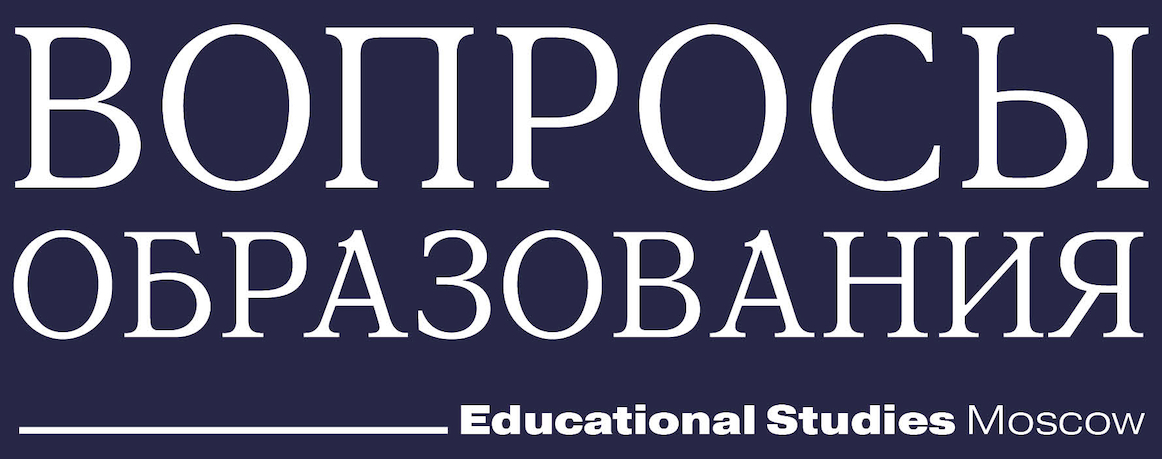Образовательный опыт студентов и его место в современной образовательной парадигме: кейс ДВФУ
Аннотация
С развитием проекта по созданию кампусов мирового уровня в России тема связи организации университетского кампуса с образовательным опытом студентов стала очень актуальной, но остается малоизученной. Цель данной работы заключается в определении образовательной парадигмы, в которой функционируют современные российские университеты, а также в изучении взаимоотношений между университетским пространством и образовательным опытом студентов на примере Дальневосточного федерального университета. Он имеет университетский кампус на острове Русский и представляет собой уникальный российский кейс современного кампуса.
С опорой на теоретическую рамку Р. Бекерса и его коллег «цель — процесс — место» проведен дедуктивный анализ материалов 39 полуструктурированных интервью со студентами ДВФУ, собранных в 2022 г. Анализ полученных данных показал, что высшее образование претерпевает переход от традиционного бихевиористического подхода к социальному конструктивизму, что проявляется, в частности, в запросе студентов на расширение свободы в выборе не только того, что изучать, но и когда и как. Образовательный процесс вышел за пределы аудитории, и образовательная среда стала неотъемлемой частью образовательного опыта студентов. У студентов появилась потребность не только в учебных пространствах, но и в местах, в которых они могут восстановить свои ресурсы. Так, наличие зеленых насаждений на территории кампуса, набережной с выходом к воде оказывает благоприятное воздействие на эмоциональное состояние студентов, а коворкинги и кофейни способствуют более продуктивному обучению. В то же время оторванность кампуса от материка, наличие внутренних правил поведения и особенностей коммуникации формирует у некоторых студентов восприятие кампуса как «лакшерной тюрьмы» — пространства с комфортной инфраструктурой, из которого трудно выбраться. Особенно остро изолированность и замкнутость кампуса переживается в период экзаменов, когда эмоциональная перегруженность студентов достигает пика.
Результаты будут полезны для российских университетов — участников проекта по созданию кампусов мирового уровня и для исследователей, которые занимаются изучением образовательного пространства.
Скачивания
Литература
Astin A.W. (1993) What Matters in College? Four Critical Years Revisited. Vol. 1. San Francisco: Jossey-Bass.
Barr R.B., Tagg J. (1995) From Teaching to Learning—A New Paradigm for Undergraduate Education. Change: The Magazine of Higher Learning, vol. 27, no 6, pp. 12–26. https://digitalcommons.unomaha.edu/slcehighered/60
Beckers R., van der Voordt T., Dewulf G. (2015) A Conceptual Framework to Identify Spatial Implications of New Ways of Learning in Higher Education. Facilities, vol. 33, no 1/2, pp. 2–19. http://dx.doi.org/10.1108/F-02-2013-0013
Bers T.H., Smith K.E. (1991) Persistence of Community College Students: The Influence of Student Intent and Academic and Social Integration. Research in Higher Education, vol. 32, pp. 539–556. https://doi.org/10.1007/BF00992627
Blyth A., Velissaratou J. (2019) Analytical Framework for Case Study Collection. Paris: OECD. Available at: http://www.oecd.org/officialdocuments/publicdisplaydocumentpdf/?cote=EDU/EDPC/GNEELE(2018)3/REV1&docLanguage=En (accessed 8 August 2024).
Bratman G.N., Hamilton J.P., Daily G.C. (2012) The Impacts of Nature Experience on Human Cognitive Function and Mental Health. Annals of the New York Academy of Sciences, vol. 1249, no 1, pp. 118–136. https://doi.org/10.1111/j.1749-6632.2011.06400.x
Center for Strategic Research, VEB RF, University "20.35" (2021) University Campuses and the City: Cooperation for the Sake of Competitiveness (In Russian). Available at: https://www.csr.ru/upload/iblock/3f0/kbpm276p3tau6knlzdla3d6ozz0fve0e.pdf En (accessed 8 August 2024).
Cherkasskaya Yu.S., Pimenova E.V. (2019) Coworking as a Public Space in the Structure of Higher Educational Institutions. E-Scio, no 5 (32), pp. 507–511 (In Russian).
Cox A.M., Benson Marshall M., Burnham J.A.J., Care L., Herrick T., Jones M. (2022) Mapping the Campus Learning Landscape. Pedagogy, Culture & Society, vol. 30, no 2, pp. 149–167. https://doi.org/10.1080/14681366.2020.1788124
De Boer H. (2021) COVID-19 in Dutch Higher Education. Studies in Higher Education, vol. 46, no 1, pp. 96–106. https://doi.org/10.1080/03075079.2020.1859684
Duffy F., Craig D., Gillen N. (2011) Purpose, Process, Place: Design as a Research Tool. Facilities, vol. 29, no 3/4, pp. 97–113. https://doi.org/10.1108/02632771111109243
Ershova N.R., Sungurova N.R. (2021) The Landscape Improvement of the University Campus, as a Way to Create the Image of an Educational Institution. Tendentsii razvitiya nauki i obrazovaniya, vol. 70, no 2, pp. 36–39 (In Russian). https://doi.org/10.18411/lj-02-2021-47
Gulwadi G.B., Mishchenko E.D., Hallowell G., Alves S., Kennedy M. (2019) The Restorative Potential of a University Campus: Objective Greenness and Student Perceptions in Turkey and the United States. Landscape and Urban Planning, vol. 187, July, pp. 36–46. https://doi.org/10.1016/j.landurbplan.2019.03.003
Hajrasouliha A.H., Ewing R. (2016) Campus Does Matter. Planning for Higher Education Journal, vol. 44, no 3, pp. 30–45. Available at: http://restorativeworkplace.com/wp-content/uploads/2015/07/Campus_Does_Matter-2.pdf (accessed 8 August 2024).
Hutchinson L. (2003) Educational Environment. British Medical Journal, vol. 326(7393), pp. 810–812. https://doi.org/10.1136/bmj.326.7393.810
Imms W., Mahat M. (2021) Where to Now? Fourteen Characteristics of Teachers’ Transition into Innovative Learning Environments. Teacher Transition into Innovative Learning Environments (eds W. Imms, T. Kvan), Singapore: Springer, pp. 317–334. https://doi.org/10.1007/978-981-15-7497-9_25
Isaeva N.V., Borisova L.V. (2013) Comparative Analysis of National Policies for Developing Research Universities' Campuses. University Management: Practice and Analysis, no 6, pp. 74–87 (In Russian).
Jones M.G., Brader-Araje L. (2002) The Impact of Constructivism on Education: Language, Discourse, and Meaning. American Communication Journal, vol. 5, no 3, pp. 1–10. http://ac-journal.org/journal/vol5/iss3/special/jones.pdf
Kärnä S., Julin P. (2015) A Framework for Measuring Student and Staff Satisfaction with University Campus Facilities. Quality Assurance in Education, vol. 23, no 1, pp. 47–66. https://doi.org/10.1108/QAE-10-2013-0041
Klyagin A.V., Abalmasova E.S., Garev K.V., Gruzdev I.A., Egorov A.A., Zakharova U.S. et al. (2020) First Weeks Storm: How Higher Education Entered into Reality of Pandemic. Moscow: HSE (In Russian).
Komensky Ja.A. (1989) Great Didactics. Pedagogical Legacy (eds V.M. Klarin, A.N. Dzhurinskiy), Moscow: Pedagogika, pp. 11–136 (In Russian).
Kop R., Hill A. (2020) Connectivism: Learning Theory of the Future or Vestige of the Past? International Review of Research in Open and Distributed Learning, vol. 9, no 3, pp. 1–13. https://doi.org/10.19173/irrodl.v9i3.523
Lee A.C., Maheswaran R. (2011) The Health Benefits of Urban Green Spaces: A Review of the Evidence. Journal of Public Health, vol. 33, no 2, pp. 212–222. https://doi.org/10.1093/pubmed/fdq068
Ledniova V.S., Moshurova L.V., Korchagina N.S., Kolomatskaia V.V. (2020) The Paradigms of Modern Education. Education and Pedagogy: Theory, Methodology, Experience (eds Zh.V. Murzina, O.L. Bogatyreva), Cheboksary: Sreda, pp. 72–81 (In Russian).
MacKean G. (2011) Mental Health and Well-Being in Post-Secondary Education Settings. A Literature and Environmental Scan to Support Planning and Action in Canada. Available at: https://citeseerx.ist.psu.edu/document?repid=rep1&type=pdf&doi=8c2428f276e643d92a0937f3251617ddec46b5f9 (accessed 8 August 2024).
Manuylov Y.S. (2016) Environmental Approach in the Context of Lev Vygotsky's Pedagogical Ideas. Vestnik of Kostroma State University. Series: Pedagogy. Psychology. Sociokinetics, no 4, pp. 315–319 (In Russian).
Marais N. (2011) Connectivism as Learning Theory: The Force behind Changed Teaching Practice in Higher Education. Education, Knowledge and Economy, vol. 4, no 3, pp. 173–182. http://dx.doi.org/10.1080/17496896.2010.556478
Mayhew M.J., Rockenbach A.N., Bowman N.A., Seifert T.A., Wolniak G.C. (2016) How College Affects Students: 21st Century Evidence that Higher Education Works, vol. 1, San Francisco: John Wiley & Sons.
McLaughlin P., Faulkner J. (2012) Flexible Spaces… What Students Expect from University Facilities. Journal of Facilities Management, vol. 10, no 2, pp. 140–149. https://doi.org/10.1108/14725961211218776
Merriam S.B., Caffarella R.S., Baumgartner L.M. (2007) Learning in Adulthood: A Comprehensive Guide. San Francisco, CA: John Wiley & Sons/Jossey-Bass.
Murphy M.C., Gopalan M., Carter E.R., Emerson K.T., Bottoms B.L., Walton G.M. (2020) A Customized Belonging Intervention Improves Retention of Socially Disadvantaged Students at a Broad-Access University. Science Advances, no 6, Article no eaba4677. https://www.science.org/doi/pdf/10.1126/sciadv.aba4677
Ninnemann K., Liedtke B., den Heijer A., Gothe K., Loidl-Reisch C., Nenonen S., Nestler J., Tieva A., Wallenborg C. (2020) Hybrid Environments for Universities. Berlin: Waxmann Verlag. http://dx.doi.org/10.31244/9783830991793
Payne S. (2009) Open Space: People Space. Book review. Journal of Environmental Psychology, vol. 29, no 4, pp. 532–533. https://doi.org/10.1016/j.jenvp.2009.10.007
Rudd T., Gifford C., Morrison J., Facer K. (2006) What if …Re-Imagining Learning Spaces. Bristol: Future Lab.
Sankari I., Peltokorpi A., Nenonen S. (2018) A Call for Co-Working–Users’ Expectations Regarding Learning Spaces in Higher Education. Journal of Corporate Real Estate, vol. 20, no 2, pp. 117–137. https://doi.org/10.1108/JCRE-03-2017-0007
Shcheglova I., Vilkova K., Dremova O. (2022) Online Learning: Expectations versus Reality. Digital Transformation and Disruption of Higher Education (ed. A. Kaplan), Cambridge: Cambridge University, pp. 22–33.
Siemens G. (2008) Learning and Knowing in Networks: Changing Roles for Educators and Designers. Paper 105: University of Georgia IT. Available at: http://it.coe.uga.edu/itforum/Paper105/Siemens.pdf (accessed 2 August 2024).
Stanton A., Zandvliet D., Dhaliwal R., Black T. (2016) Understanding Students’ Experiences of Well-Being in Learning Environments. Higher Education Studies, vol. 6, no 3, pp. 90–99. https://doi.org/10.5539/hes.v6n3p90
Tharani A., Husain Y., Warwick I. (2017) Learning Environment and Emotional Well-Being: A Qualitative Study of Undergraduate Nursing Students. Nurse Education Today, vol. 59, December, pp. 82–87. https://doi.org/10.1016/j.nedt.2017.09.008
Triguero-Mas M., Dadvand P., Cirach M., Martínez D., Medina A., Mompart A., Nieuwenhuijsen M.J. (2015) Natural Outdoor Environments and Mental and Physical Health: Relationships and Mechanisms. Environment International, vol. 77, April, pp. 35–41. https://doi.org/10.1016/j.envint.2015.01.012
Valks B., Blokland E., Elissen C., van Loon I., Roozemond D., Uiterdijk P., Arkesteijn M., Koutamanis A., Den Heijer A. (2021) Supporting Strategic Decision-Making on the Future Campus with Space Utilisation Studies: A Case Study. Property Management, vol. 39, no 4, pp. 441–465. https://doi.org/10.1108/PM-09-2020-0054
Valtonen T., Leppänen U., Hyypiä M., Kokko A., Manninen J., Vartiainen H., Hirsto L. (2021) Learning Environments Preferred by University Students: A Shift Toward Informal and Flexible Learning Environments. Learning Environments Research, vol. 24, November, pp. 371–388. https://doi.org/10.1007/s10984-020-09339-6
Vilkova K., Shcheglova I., Dremova O. (2021) The Challenges of Distance Learning to Student Mental Health. Higher Education in Russia and Beyond, vol. 27, no 2, pp. 12–14.
Vinogradova I,A., Ivanova E.V. (2017) Study of Students’ and Teachers’ Opinion on University Environment. Pedagogical Review, no 1 (15), pp. 62–71 (In Russian). https://doi.org/10.23951/2307-6127-2017-1-62-71
Zagirova F.R. (2018) Academic Diversity and University Governance: The Formation of a Research Agenda. University Management: Practice and Analysis, vol. 22, no 3, pp. 141–154 (In Russian). https://doi.org/10.15826/umpa.2018.03.033








